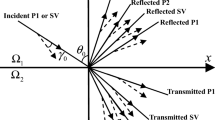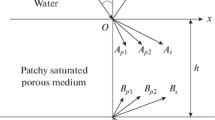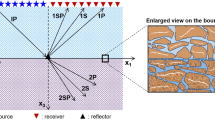Abstract
Present paper aims to study the phenomenon of reflection and transmission when an inhomogeneous wave strikes some discontinuity in a composite porous medium saturated by two immiscible viscous fluids. The incident wave splits into six reflected and six transmitted waves at the interface. All reflected and transmitted waves are inhomogeneous in nature with different directions of propagation vector and attenuation vector. A dimensionless parameter \(\varsigma \in [0, 1]\) is introduced to represent the extent of connection among the pores at the interface. Expression of Umov–Poynting vector is derived to obtain energy flux vector. Continuity of energy flux vector at the interface gives the required boundary conditions for the system. Connecting parameter \(\varsigma \) is also employed in boundary conditions to model the partial connection of pores at the interstices of two media. For numerical discussion we consider a porous medium composed of sandstone and ice, saturated with oil and water. The effect of parameter \(\varsigma \) and angle of incidence is determined numerically on the amplitude and the energy ratios of reflected and transmitted waves.








Similar content being viewed by others
Abbreviations
- \(S_\mathfrak {f}\) :
-
Saturation of each fluid phase
- \(S_{s_\mathfrak {f}}\) :
-
Fraction of each solid in composite matrix
- \(R_{11}\), \(R_{22}\) :
-
Coefficients related to viscous drag
- \(A_{11}\), \(A_{22}\) :
-
Coefficients related to inertial drag of first solid
- \(B_{11}\), \(B_{22}\) :
-
Coefficients related to inertial drag of second solid
- \(A_{12}\) :
-
Inertial coupling parameter connecting fluid phases
- \(G_{s_{\mathfrak f}}\) :
-
Shear modulus of each solid phase
- \(k_\beta \) :
-
Complex wave number of dilatational wave
- \(k_l\) :
-
Complex wave number of rotational wave
- \(w_i^{\mathfrak {f}},\) :
-
Normal component of drainage velocity of pore fluids
- \(\hat{a}\) :
-
Unit normal vector to surface \(\varvec{S}\)
- \(F, F^\prime \) :
-
Time averaged energy flux along normal at interface in both half spaces
- \(T_1\), \(T_2\) :
-
Surface flow impedance for both fluids
- \(A_m\) :
-
Attenuation vector of propagating waves
- \(P_m\) :
-
Propagation vector of propagating waves
- \(A_o\) :
-
Attenuation vector of incident wave
- \(P_o\) :
-
Propagation vector of incident wave
- s :
-
Slowness vector of a wave
- \(s_x\), \(s_z\) :
-
Horizontal and vertical components of slowness
- \(s_{mz}\) :
-
Vertical slowness of propagating waves
- \(Z_o\) :
-
Amplitude of incident wave
- \(Z_m\) :
-
Amplitude of reflected waves
- \(Z_m^{\prime }\) :
-
Amplitude of transmitted waves
- \(F_{mm}\) :
-
Orthodox energy flux
- \(F_{mn}\) :
-
Interference energy flux
- \(F_o\) :
-
Energy flux due to incident wave
- \(E_{mn}\) :
-
Energy ratios of reflected waves to incident wave
- \(E_{mn}^\prime \) :
-
Energy ratios of transmitted waves to incident wave
- \(K_{\alpha }\) :
-
Bulk modulus of \(\alpha \) phase
- \(K_{s_{\mathfrak {f}}}\) :
-
Drained bulk modulus of solids
- \(\mathbb {K}_{\mathfrak f}\) :
-
Permeability of solid phases
- \(\mathfrak {T}_{s_\mathfrak {f}}\) :
-
Tortuosity of solids
- \(K_{r_\mathfrak {f}}\) :
-
Relative permeability of fluids
- f :
-
Porosity of medium
- \(p_c\) :
-
Capillary pressure difference between fluids
- \(\mathfrak {h}\), \(\mathfrak {n}\), \(\mathfrak {g}\) :
-
Fitting parameters
- \(\rho _\alpha \) :
-
Density for the phase \(\alpha \)
- \(\theta _\alpha \) :
-
Volume fraction for the phase \(\alpha \)
- \(\sigma ^\alpha \) :
-
Partial stress for the phase \(\alpha \)
- \(\sigma _{ij}^ \alpha \) :
-
Stress tensor of each phase
- \(\epsilon _{ij}^\alpha \) :
-
Strain tensor of each phase
- \(\varGamma ^{\mathfrak {f}}\) :
-
Coefficients related to effective stress
- \( \sigma \) :
-
Sum of normal stresses of each phase
- \(\varsigma \) :
-
A parameter representing connection pores at interface
- \(\theta _o\) :
-
Angle of incidence
- \(\varOmega \) :
-
Upper half space
- \(\varOmega ^\prime \) :
-
Lower half space
- \(\eta _{\mathfrak f}\) :
-
Viscosity of fluid phases
- \(\gamma _m\) :
-
Angle of attenuation of propagating waves
- \(\gamma _o\) :
-
Angle of attenuation of incident wave
References
Adamo F, Andria G, Attivissimo F and Giaquinto N 2004 An acoustic method for soil moisture measurement; IEEE Trans. Inst. Meas. 53 891–898.
Arora A and Tomar S K 2007 Elastic waves at porous/porous elastic half spaces saturated by two immiscible fluids; J. Porous Media 8 751–768.
Arora A, Bala N and Tomar S K 2016 A mathematical model for wave propagation in a composite solid matrix containing two immiscible fluids; Acta Mech. 227 1453–1467.
Biot M A 1956a Theory of propagation of elastic waves in a fluid saturated porous solid: I. Low frequency range; J. Acoust. Soc. Am. 28 168–178.
Biot M A 1956b Theory of propagation of elastic waves in a fluid saturated porous solid: II. Higher frequency range; J. Acoust. Soc. Am. 28 179–191.
Biot M A 1962 Mechanincs of deformation and acoustic propagation in porous media; J. Appl. Phys. 33 1482–1498.
Blum A, Flammer I, Friedli T and Germann P 2004 Acoustic tomography applied to water flow in unsaturated soils; Vadose Zone J. 3 288–299.
Borcherdt R D 1977 Reflection and refraction of type-II S waves in elastic and anelastic media; Bull. Seismol. Soc. Am. 67 43–67.
Borcherdt R D 1982 Reflection-refraction of general P and type-I S waves in elastic and anelastic solids; Geophys. J. Roy. Astron. Soc. 70 621–638.
Carcione J M 2014 Wave field in real media: Wave propagation in anisotropic, anelastic, porous and electromagnetic media; 3rd edn, Elsevier Science, Amsterdam.
Deckers E, Claeys C, Atak O, Groby J P, Dazel O and Desmet W 2016 A Waves based method to predict the absorption, reflection and transmission coefficient of two dimensional rigid frame porous structures with periodic inclusions; J. Comput. Phys. 312 115–138.
Denneman A I M, Drijkoningen G G, Smeulders D M J and Wapenar K 2002 Reflection and transmission of waves at a fluid/porous medium interface; Geophysics 67 282–291.
Deresiewicz H and Rice J T 1962 The effect of boundaries on wave propagation in a liquid filled porous solid-III: Reflection of plane waves at a free plane boundary; Bull. Seismol. Soc. Am. 52 595–626.
Deresiewicz H and Skalk R 1963 On uniqueness in dynamic poroelasticity; Bull. Seismol. Soc. Am. 53 793–799.
Deresiewicz H and Levy A 1967 The effect of boundaries on wave propagation in a liquid filled porous solid-X: Transmission through a stratified medium; Bull. Seismol. Soc. Am. 57 381–391.
Dutta N C, and Ode H 1983 Seismic reflections from a gas water contact; Geophysics 48 148–162.
Geertsma J and Smith D C 1961 Some aspects of elastic wave propagation in a fluid saturated porous solids; Geophysics 26 169–181.
Gorodetskaya N S 2005 Wave reflection from the free boundary of porous elastic liquid saturated half space; Int. J. Fluid Mech. Res. 32 327–339.
Hajra S and Mukhopadhyay A 1982 Reflection and refraction of seismic waves incident obliquely at the boundary of a liquid saturated porous solid; Bull. Seismol. Soc. Am. 72 1509–1533.
Krebes E S 1983 The viscoelastic reflection/transmission problem: two special cases; Bull. Seismol. Soc. Am. 73 1673–1683.
Kumar M and Sharma M D 2013 Reflection and transmission of attenuated waves at the boundary between two dissimilar poroelastic solids saturated with two immiscible viscous fluids; Geophys. Prospect. 61 1035–1055.
Leclaire P, Cohen-Tenoudji F and Aguirre-Puente J 1994 Extension of Biot’s theory of wave propagation to frozen porous media; J. Acoust. Soc. Am. 96 3753–3768.
Lo W C, Sposito G and Majer E 2005 Wave propagation through elastic porous media containing two immiscible fluids; Water Resour. Res. 41 1–20.
Rubino J G, Ravazzoli C L and Santos J E 2006 Reflection and transmission of waves in composite porous media: A quantification of energy conversions involving slow waves; J. Acoust. Soc. Am. 120 2425–2436.
Santos J E, Corbero J M, Ravazzoli C L and Hensley J L 1992 Reflection and transmission coefficients in fluid saturated porous media; J. Acoust. Soc. Am. 91 1911–1923.
Sharma M D and Saini T 1992 Pore alignment between two dissimilar saturated poroelastic media: reflection and refraction at the interface; Int. J. Solids Struct. 29 1361–1377.
Sharma M D 2004 \(3\)-D wave propagation in a general anisotropic poroelastic medium: Reflection and refraction at an interface with fluid; Geophys. J. Int. 157 947–958.
Sharma M D 2005 Propagation of inhomogeneous plane waves in dissipative anistropic poroelastic solids; Geophys. J. Int. 163 981–990.
Sharma M D 2008 Wave propagation across the boundary between two dissimilar poroelastic solids; J. Sound Vib. 314 657–671.
Sharma M D 2009 Boundary conditions for porous solids saturated with viscous fluid; Appl. Math. Mech. (English Edition) 30 821–832.
Tomar S K and Arora A 2006 Reflection and transmission of elastic waves at an elastic porous solid saturated by two immiscible fluids; Int. J. Solids Struct. 43 1991–2013.
Vashisth A, Sharma M D and Gogna M L 1991 Reflection and transmission of elastic waves at a loosely bounded interface between an elastic solid and liquid saturated porous solid; Geophys. J. Int. 105 601–617.
Vlastislav C and Ivan P 2005 Plane waves in viscoelastic anistropic media I. Theory; Geophys. J. Int. 161 197–212.
Yeh C L, Lo W C, Jan C D and Yang C C 2010 Reflection and refraction of obliquely incident elastic waves upon the interface between two porous elastic half spaces saturated by different fluid mixtures; J. Hydrol. 395 91–102.
Zhao X and Shen H 2015 Ocean wave transmission and reflection by viscoelasic ice covers; Ocean Model. 92 1–10.
Acknowledgements
One of the authors (AA) is tankful to the Council of Scientific and Industrial Research (CSIR), New Delhi for providing financial support under Scheme No. 25(0243)/15/EMR-II to complete this work.
Author information
Authors and Affiliations
Corresponding author
Additional information
Corresponding editor: M Radhakrishna
Appendices
Appendix 1
(a) The elements of matrices appearing in equation (2) are given below.
Non-zero elements of symmetric matrix \([\mathcal {L}]\) are
where
(b) Expressions of coefficients appearing due to inertial and viscous drag
where \(K_{\alpha }\) represents bulk modulus of each phase. \(\mathbb {K}_{s_1}\) and \(\mathbb {K}_{s_2}\) represent permeability of first and second solid, respectively whereas \(\eta _\mathfrak {f}\) corresponds to viscosity of fluid phases. The symbols \(\mathfrak {T}_{s_1}\), \(\mathfrak {T}_{s_2}\) correspond to the tortuosity of the solids, which depends upon porosity. For numerical purpose their values are obtained from the relation \(\mathfrak {T}_{s_1}= \mathfrak {T}_{s_2} = \displaystyle \frac{1}{2}\left( 1+({1}/{f})\right) \). The symbols \(S_\mathfrak {f}=\displaystyle {\theta _\mathfrak {f}}/{f}\) and \(S_{s_\mathfrak {f}}=\displaystyle {\theta _{s_\mathfrak {f}}}/{\theta _s},~~~(\theta _s=\theta _{s_1}+\theta _{s_2})\) correspond to saturation of fluid phases and solid fraction in composite matrix, respectively. Pore space is considered to be completely filled by fluids. Mathematically, this can be written as \(S_1+S_2=1\). Dry bulk modulus and shear modulus of each solid is depicted by \(K^d_{s_\mathfrak {f}}\), \(G_{s_\mathfrak {f}}\). The term \(p_c\) signifies the pressure difference between fluid phases. For numerical example we consider \(\mathfrak {i}=25\times 10^{-5}\). The symbols \(\mathfrak {g}=1-({1}/{\mathfrak {h}})\), \(\mathfrak {h}\) and \(\mathfrak {i}\) correspond to fitting parameters involved in understanding the soil water content in Van ganuchten model (1980). The values of these independent parameters may be obtained by finding the best fit of soil water retention curve to experimental data. In most of cases the method of least squares is used to find the value of these parameters. The parameter \(\eta \) is also a fitting parameter, which is employed to find the relative permeability of wetting and non-wetting fluids as a function of water saturation.
Appendix 2
The expressions of coupling coefficients
where Det is employed to symbolize the determinant of a matrix. Also,
Appendix 3
The explicit expressions of elements of matrix given in equation (40) are
Elements of matrix \(\mathcal C\) if P waves are incident.
Also,
\(J_\beta =(a_{11}-\frac{2}{3}G_{s_1}+a_{12}\lambda ^\beta _1+a_{13}\lambda ^\beta _2+a_{14}\lambda ^\beta _{s_2})\), \(M_\beta =a_{14}+a_{24}\lambda ^\beta _1+a_{34}\lambda ^\beta _2+(a_{44}-\frac{2}{3}G_{s_2})\lambda ^\beta _{s_2}\),
where \(s_{mz}\) corresponds to vertical slowness of all propagating waves.
Rights and permissions
About this article
Cite this article
Bala, N., Arora, A. Effect of pore connectivity on reflection amplitudes of an inhomogeneous wave in a composite porous solid saturated by two immiscible fluids. J Earth Syst Sci 127, 59 (2018). https://doi.org/10.1007/s12040-018-0962-z
Received:
Revised:
Accepted:
Published:
DOI: https://doi.org/10.1007/s12040-018-0962-z




